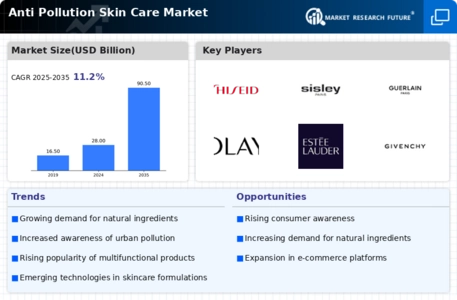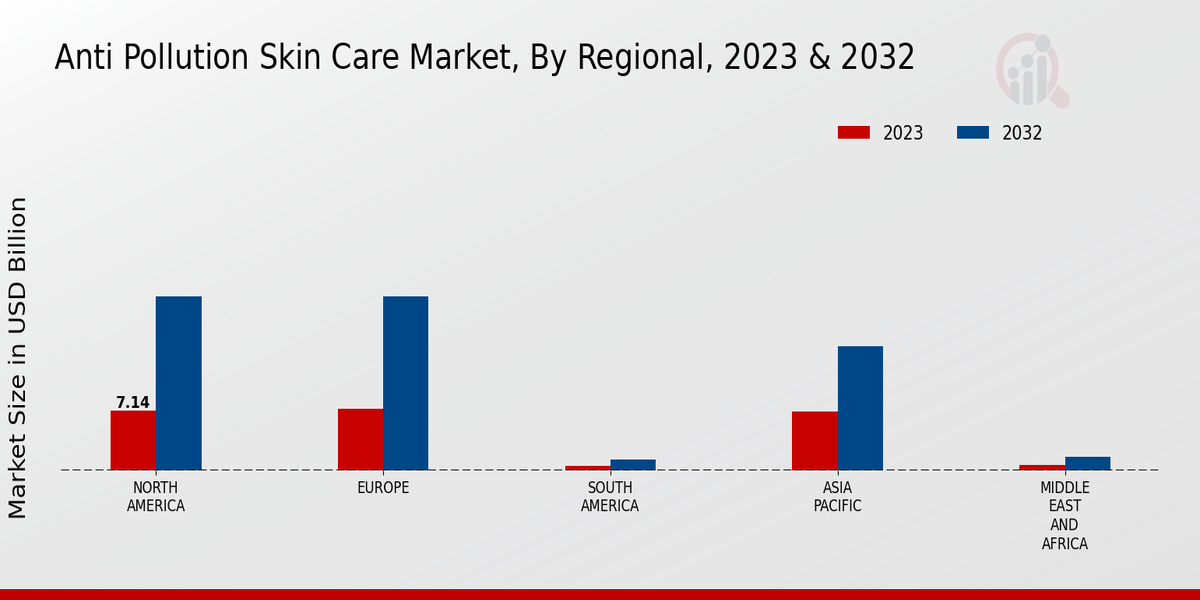Rising Urbanization
The Global Anti Pollution Skin Care Market Industry is experiencing growth driven by increasing urbanization. As more individuals migrate to urban areas, they are exposed to higher levels of pollution, which can adversely affect skin health. Urban centers often have elevated levels of particulate matter and other pollutants, leading to skin issues such as premature aging and irritation. This trend is particularly evident in developing countries where urban populations are projected to rise significantly. The demand for anti-pollution skincare products is likely to increase as consumers seek solutions to combat the effects of urban living on their skin.
Market Growth Projections
The Global Anti Pollution Skin Care Market Industry is poised for substantial growth, with projections indicating a market size of 28.0 USD Billion in 2024 and an anticipated increase to 90.5 USD Billion by 2035. This growth trajectory suggests a compound annual growth rate of 11.24% from 2025 to 2035. Such figures underscore the rising consumer demand for products that mitigate the effects of environmental pollution on skin health. The industry is likely to expand as brands innovate and adapt to changing consumer preferences, positioning themselves to capture a larger share of this burgeoning market.
Increased Disposable Income
Rising disposable income levels globally are contributing to the expansion of the Global Anti Pollution Skin Care Market Industry. As consumers have more financial resources, they are more willing to invest in premium skincare products that offer protection against pollution. This trend is particularly evident in emerging markets where economic growth is leading to an increase in consumer spending on personal care. The willingness to spend on high-quality anti-pollution skincare products is expected to drive market growth, with a projected compound annual growth rate of 11.24% from 2025 to 2035, reflecting the increasing prioritization of skincare in consumers' budgets.
Innovative Product Development
The Global Anti Pollution Skin Care Market Industry is witnessing a surge in innovative product development. Brands are increasingly formulating products that incorporate advanced technologies and ingredients designed to combat pollution-related skin damage. For instance, the introduction of serums and creams containing antioxidants, peptides, and botanical extracts is becoming commonplace. These innovations not only address existing skin concerns but also provide preventive measures against future damage. As the market evolves, consumers are likely to gravitate towards products that offer multifunctional benefits, thereby driving the industry's growth trajectory towards an estimated 90.5 USD Billion by 2035.
Growing Awareness of Skin Health
Consumer awareness regarding skin health is a pivotal driver for the Global Anti Pollution Skin Care Market Industry. As individuals become more informed about the detrimental effects of pollution on skin, they are increasingly seeking products that offer protection and repair. Educational campaigns and social media influence have played a crucial role in disseminating information about the importance of anti-pollution skincare. This heightened awareness is reflected in the market's projected growth, with the industry expected to reach 28.0 USD Billion in 2024. Consumers are now more inclined to invest in skincare products that promise to shield their skin from environmental aggressors.
Regulatory Support for Clean Beauty
Regulatory bodies are increasingly advocating for clean beauty standards, which is positively influencing the Global Anti Pollution Skin Care Market Industry. Governments are implementing regulations that promote the use of safe and environmentally friendly ingredients in skincare products. This regulatory support encourages brands to develop formulations that are not only effective against pollution but also align with consumer demand for sustainability. As a result, the market is likely to benefit from a growing number of clean beauty products that cater to environmentally conscious consumers. This trend may further enhance the industry's growth potential in the coming years.













